San Poil Literature
The Sanpoil (or San Poil) are a Native American people of the U.S. state of Washington. They are one of the Salish peoples and are one of the twelve members of the Confederated Tribes of the Colville Reservation.
The name Sanpoil comes from the Okanagan [snpʕwílx], “gray as far as one can see”. It has been folk-etymologized as coming from the French sans poil, “without fur”. The Yakama people know the tribe as Hai-ai’-nlma or Ipoilq. The Sanpoil call themselves Nesilextcl’n, .n.selixtcl’n, probably meaning “Salish speaking,” and N’pooh-le, a shortened form of the name. The Sanpoil had a semi-democratic system of government with various chiefs representing each community within the tribe. Heredity was not a requirement for chiefs. In later years, United States government officials began recognizing one chief at a time.
The last four officially recognized chiefs of the San Poil Tribe were Que Que Tas (b. 1822-d.1905), his son Nespelem George (b. 1863-d. Jan. 29, 1929), Skolaskin, and Jim James. The mother of Que Que Tas was a woman chief who met Lewis and Clark on the great plateau when they came through on the Pacific Northwest Expedition.
Since the 17th century the Sanpoil flourished with a large number of villages along the Sanpoil River and Nespelem River, tributaries of the Columbia River Later, the tribe was placed on Sanpoil and Colville Reservations in Washington state. The San Poil Tribe was incorporated into the Colville Confederation by Executive Order from the President of the United States after strong recommendation from the Indian agents noting the San Poil’s relatively peaceful nature toward others (especially European settlers).
The Sanpoil are considered Interior Salish Native Americans, a designation that also includes the Okanagan, Sinixt, Lakes, Wenatchee, Nespelem, Spokan, Kalispel, Pend d’Oreilles, Coeur d’Alene, and Flathead peoples.
Ross classifies Nespelem as one of the Okanagan tribes, while Winans classifies them as part of the Sanpoil. There is little cultural and linguistic difference between the San Poil and the Nespelem.
In 1905, the United States Indian Office counted 324 Sanpoil and 41 Nespelem. In 1910, the Census counted 240 and 46. In 1913, after a survey, the Office of Indian Affairs counted 202 and 43.
Sanpoil is a Salish language belonging to the inland division of Salishan languages typical of Plateau nations, and related most closely to Salishan languages’ eastern section.
Nesilextcl’n, the dialect of Salish spoken by the San Poil, is no longer taught in schools or spoken by the younger generations. While a few fluent speakers remain, all are senior citizens. Without language preservation efforts, the dialect will be lost to the San Poil people and to the world.

Chipmunk and meadowlark
(two children attacked by a monster)
Coyote becomes chief of the salmon
(adventures of coyote)
Coyote’s Salmon
(Coyote teaches the Sanpoil to harvest salmon
Long ago on the Sanpoil River that flows southward into the Columbia River, Old Man and old Woman lived with their tribe, the Sanpoils. They were so stooped that it appeared they were walking on their knees and their elbows. Their very pretty granddaughter lived with them.
One day Coyote came along and saw the old couple with the beautiful girl. Immediately, he decided that he wanted the girl for his wife. But he knew better than to ask for her then. He thought he would wait until evening. So during the day he sat around, becoming better acquainted with the family.
The old couple watched him, noting that his long hair was braided neatly and his forelocks were carefully combed back. They noticed too that he was tall and strong. Old Man and Old Woman talked between themselves about Coyote, wondering if he could be a Chief.
In the late afternoon, Coyote asked Old Man, “What is that thing down in the stream?”
“Why, that is my fish trap,” Old Man replied.
“A fish trap? What is that? What do you do with it?” asked Coyote, pretending he did not know.
“Oh, occasionally I catch a few bullheads and sunfish,” Old Man said.
“Is that what you eat? I never heard of them. Are they big enough for a meal?” asked Coyote.
“They are not much, but what else can we eat?” replied Old Man.
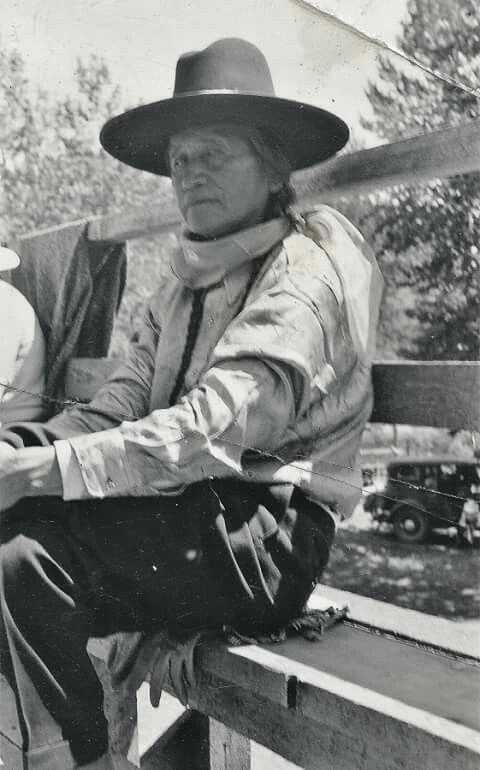
“I think I will go up the hill and look around,” said Coyote. It was then about an hour before sunset.
On top of the hill, Coyote saw some grouse roosting in a tree. He threw some stones at them, killing five. He carried the grouse back to Old Man and said, “Let’s eat these for supper.”
After removing the feathers, Old Man roasted the game over the fire and when they were done, everyone sat down to eat the wonderful meal. To Old Man and his family, it seemed like a feast.
“Is this the kind of food you eat every day?” the Old Man asked Coyote.
“Sometimes I eat berries, roots, and I catch some real big fish, as long as your arm,” Coyote said.
Later, Coyote announced that he would like to stay there if they wanted him, otherwise he would move on.
“What do you mean?” asked Old Man.
“Well, it is like this. I would like to marry your granddaughter,” said Coyote.
Old Man and Old Woman looked at each other but said nothing. Coyote went for a little walk to allow the old couple to talk privately.
While Coyote was gone Old Man said to his wife, “What do you think of this fellow? You saw what he did, bringing good food for our supper. If we let him marry our granddaughter, maybe they will stay here and we will have such good food always. Surely our girl will marry someone soon, perhaps some man not as good as this young fellow.”
“Well, husband, I’ll leave it entirely up to you.”
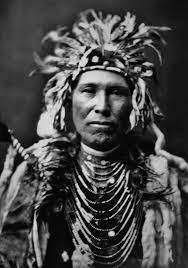
Soon Coyote returned. He decided to let Old Man open the conversation. Old Man held his pipe in one hand and said, “How I wish I had a smoke. My tobacco ran out some time ago.”
“Have some of mine,” said Coyote, reaching into his jacket pocket. He pulled out a large bunch of tobacco and gave it to Old Man, who filled his pipe, feeling very much surprised that Coyote would have real tobacco.
After a while Old Man spoke, “My wife and I have talked over your proposal and she left the decision up to me. I have decided to let you marry our granddaughter and live here. If you go away, we want you to take her with you. How are we to know that you will do this?”
“You need not worry,” said Coyote. “I am tired of travelling. I want to settle down here for the rest of my life, if you wish.”
Old Man was pleased with Coyote and believed what he said. So Coyote took the pretty granddaughter for his wife.
Early that evening Coyote stayed with his wife and later said, “I am going out for a few minutes and when I return we will go to bed.”
“All right,” answered his wife.
Coyote went downstream to where Old Man had his fish trap. He changed it into a basket-type trap, piling rows of rocks to guide fish into the basket. When finished he called out, “Salmon, I want two of you in the basket trap tomorrow morning, one male and one female.” Then he returned to his bride.
Next morning Coyote asked Old Man to go to his fish trap early. “I think I heard a noise in the night that sounded like fish caught in a trap,” he said.
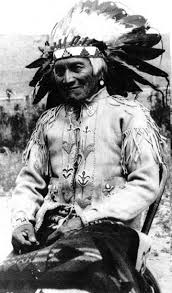
Old Man went downstream to see his fish trap. Sure enough, he saw two big fish in the trap. Old Man was so excited, he stumbled up the trail toward Coyote.
“You were right, there are two great fish in the trap bigger than I have ever seen,” reported Old Man.
“You must be dreaming,” said Coyote.
“Come down with me and see for yourself,” Old Man said.
When the two reached the trap, Coyote exclaimed, “You are so right. These are salmon, chief among all fish. Let us take them over to that flat place, and I will show you what to do with them.”
When they reached the open field, Coyote sent Old Man up the hill to gather sunflower stems and leaves.
“Those are salmon plants,” Coyote explained. “Salmon must always be laid on sunflower stems and leaves.”
Old Man spread the sunflower plants upon the ground. Coyote placed the salmon on them, and proceeded to show Old Man how to prepare the salmon.
“First, put a stick in the salmon’s mouth and bend it back to break off the head. Second, place long sharp poles inside the salmon lengthwise to hold for roasting over your campfire,” said Coyote.
“Now remember this,” he continued. “The first week go down to the trap and take out the salmon every day. But when fixing it, never use a knife to cut it in any way. Always roast the fish over the fire on sticks, the way I have shown you. Never boil salmon the first week. After the salmon is roasted, open it carefully and take out the backbone without breaking it. Also, save the back part of the head for the sacred bundle-never eat that.
“If you do not do these things as I have told you, either a big storm will come up and you will be drowned, or you will be bitten by a rattlesnake and you will die.
“After you have taken out the salmon’s backbone, wrap it and the back of the head carefully in tules, the marsh grasses, to make a sacred bundle, then place it somewhere in a tree, where it will not be bothered. If you do as I tell you, you will always have plenty of salmon in your trap.

“I am telling you these sacred things about the salmon because I am going to die sometime. I want you and your tribe to know of the best way to care for and use your salmon. After this, your men will always place their fish traps up and down the river to catch salmon. The man having the first trap will be Chief of the Salmon, and the others should always do anything he tells them to do.
“After the first week of the salmon season, you can boil your salmon or cook it any way you wish. But remember to always take care of the bones, wrapping them in a sacred bundle–never leaving them where they can be stepped upon or stepped over.”
For the next few days each time Old Man went down to his fish trap in the morning, he found twice as many salmon as on the day before. Coyote showed him how to dry fish to prepare them for winter use. Before long they had a large scaffold covered with drying fish.
People of the Sanpoil tribe saw the fish and noticed how well Old Man and Old Woman were doing. They went to their hogans and told others about the big red fish called salmon, and about the tall young stranger who taught Old Man about caring for the salmon.
Soon thereafter, all the people came to see for themselves. Old Man and Old Woman invited them to feast on their roasted salmon. The old couple explained how their new grandson-in-law had shown them how to trap the salmon and dry them for winter food.
To this day, the Sanpoils say their tribe harvests the salmon in exactly the way that Coyote taught their ancestors long, long ago.
Five wolves
(boy who turned into a chickadee)
How the cold lost its power
(origin of the seasons)
Origin of different languages
(quarrel between tribes)
Rolling stone
(coyote getting in trouble with a grasshopper family)
Tick and the deer
(origin of the wood tick)
Woodpecker and the Theft of Fire
(origin of fire)
Long, long ago, in the days of the animal people, there was no fire on the earth. There was fire in the sky, but none on the earth.
One day the chief of the animal people said to those near him, “Let us go up to the sky country and try to get some fire. Tell all the people to gather here. Then I will tell you what to do.”
When the animal people had gathered together, the chief said to them, “Each of you will make a bow and many arrows. Then come together again and shoot at the sky. We’ll see if we can hit the sky. If we can, we’ll make a chain of arrows down to the earth. Then we’ll climb up to the sky country and steal some fire from the sky people.”
The people obeyed the chief’s orders–all except Woodpecker. They made long, strong bows, and they made many arrows. Then all the people came together again at one place. Everyone shot at the sky, but no one could hit it with his arrows.
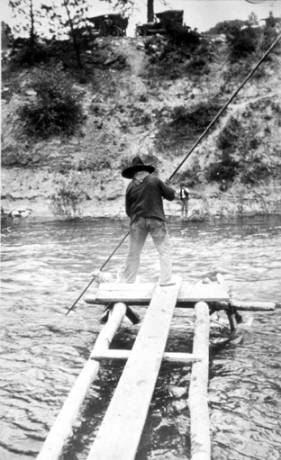
Then Woodpecker decided to get busy. First he made a bow from the rib of Elk. Then he made some arrows from the stems of serviceberry bushes.
“Where can I get some feathers for my arrows?” Woodpecker asked himself.
He saw Golden Eagle, and then he saw Bald Eagle.
Woodpecker said to Bald Eagle, “Golden Eagle has been saying mean things about you.”
Bald Eagle flew straight at Golden Eagle and began to fight him with his strong bill. That was just what Woodpecker wanted. Soon feathers were dropping from the two eagles fighting high in the air. Many feathers dropped.
Woodpecker spread out a mat and gathered all of them. He took all of the feathers home with him and fastened them to his arrows. Soon he had two big bags full of nice, feathered arrows.
“Now where can I get some points for my arrows?” Woodpecker asked his grandmother.
“Go to see Flint Rock and Hard Rock,” his grandmother told him.
Woodpecker went. And he said to Flint Rock, “Hard Rock has been saying mean things about you.”
Then Hard Rock and Flint Rock began to fight. That was just what Woodpecker wanted. Hard Rock broke Flint Rock into little pieces. Woodpecker took all the flint chips home with him and used them as arrowheads.
Woodpecker knew that in two days the animal people were going to have another meeting. They would try again to reach the sky with their arrows. So after two days Woodpecker went toward the shooting place with his two bags of arrows. When he got there, he saw Coyote.
“Why have you come?” asked Coyote. “You can’t shoot.”
“I came to look on.”

Coyote looked at Woodpecker’s bow and said, “That won’t shoot anywhere.”
All the people laughed at Woodpecker. “You can’t shoot as far as the sky,” they said.
The chief was a wise and kind chief. “Don’t make fun of Woodpecker,” he said. “He may shoot better than you think. I will call him when his time comes.”
Then the chief called on each animal, one at a time, to shoot at the sky. But no one’s arrow reached that far. At last Woodpecker’s turn came. When the chief called him, Woodpecker dropped his two bags of arrows on the ground and put a string in his bow.
“Watch me,” he said, and he shot an arrow toward the sky. It went so high it disappeared from sight. Everyone watched and waited. The arrow did not come down. Woodpecker shot another arrow. It disappeared from sight and did not come down. He kept on shooting until he had emptied one bag of arrows. By that time the animal people could see the end of the chain of arrows.
Then Woodpecker started to shoot the second bag of arrows. The people could see that each arrow stuck in the neck of the preceding arrow. When Woodpecker had emptied his second bag, the last arrow was still a long distance from the ground.
“Take some of the other people’s arrows,” said the chief.
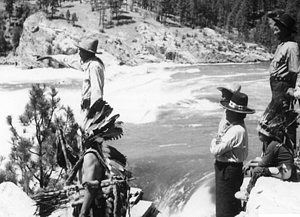
Woodpecker shot from the other animals’ bags until the chain reached the ground. Then, one by one, all the animals started up the arrow chain toward the sky. Golden Eagle was the first. The others followed him. Grizzly Bear was the last.
I’ll take some food along with me,” said Grizzly Bear. “We don’t know what we are getting into.”
So he filled a large bag with food and fastened it across his back. Then he took hold of the bottom arrow of the chain. He and his bag of food were so heavy that the arrow broke in two. He took hold of the second arrow. It broke in two. He broke the first five arrows that way. He could not reach the sixth one, so Grizzly Bear did not go up to the sky country.
By sunset all the other animal people were in the sky world.
“Let’s all look around,” said Woodpecker. “Let’s not stay bunched together. If we go one by one, some of us will be sure to find fire.”
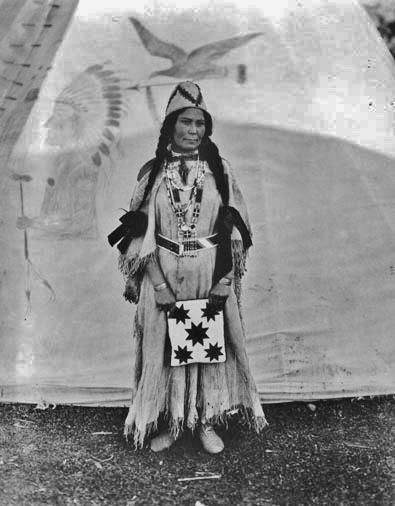
So the animals separated, and each one got some fire. As they started back toward the arrow chain, they saw the sky people coming after them. And they found that the chain of arrows was broken.
“Quick!” said Eagle. “Each bird will take an animal on his back and fly down to earth with him.”
That is the way the animals got down to earth again. Sapsucker was afraid to fly and so jumped instead. He hit the ground with his mouth. Ever since then, sapsuckers have had flat mouths and have to suck their food.
Fish slipped and fell down from Magpie’s back. He was carrying his arrows with him, and when he hit the ground, the arrows went right through his body. Ever since then, fish have had many bones.
The animal people laid the fire down in front of their chief, “You can tell us what to do with it,” they said.
The chief said to his people, “It is best to divide the fire, so that people all over the world can use it.”
So he and Grizzly Bear gave pieces of the fire to Horsefly and Hummingbird. They carried the fire into all parts of the country.
People have had fire ever since.
Executive Order establishing Columbia Reservation, 1872
Record of the San Poil Indians
8 pages published in Spokane Spokesman-Review, July 8, 1917
San Poil Indians (ask dr. dig)
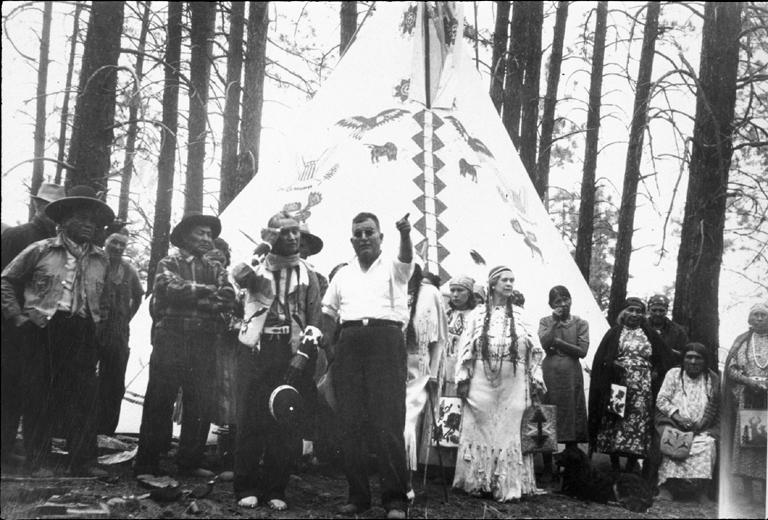
San Poil chief Jim James in ceremonial dress stands with others by his tipi at the “Ceremony of tears”, Kettle Falls, Washington, 1939.
Men & women stand in front of painted tipi; man in center wears beaded vest, wristbands, belt & moccasins, and holds hat with beaded band; stands with men in western-style clothing, several women in beaded, fringed dresses and others in print dresses; almost all hold beaded bags.
Note from unidentified source: “Ceremony of tears” at Kettle Falls, 1939 [the commemoration for the salmon & salmon habitat to be lost when the area was flooded by the building of the Grand Coulee Dam] Chief Jim James, San Poil, holding hat in hand. Photo taken in front of Chief James lodge.
While sanpoil is a native American word meaning “unknown,” the San Poil tribe has flourished since 1600 in Washington State with a large number of villages along the Sanpoil River, and the Columbia River below Big Bend, Oregon. San Poils belong to the Salishan linguistic group. They are now one of 26 tribes living on the Colville reservation in Washington State.
From American Indians of the Pacific Northwest, Library of Congress

